Hello Everyone!
After a long set of flights, I have arrived in New Zealand. We started on Wednesday, and arrive Friday – New Zealand time. In roughly one day, we flew 4 aircraft – Madison to Chicago, Chicago to San Francisco, San Francisco to Auckland, New Zealand, and then Auckland, New Zealand to Christchurch, New Zealand. Any we have one more flight to go – in a few days – to get to Antarctica.
Weather here was stormy upon arrival (see attached satellite image with nifty swirling storm system over the country). It made for a bumpy landing in Auckland. Yesterday is just poured here – lots of rain – terrible weather. Of course, it is good to see them get some rain, things here are too dry – its near drought conditions (and odd to land in Christchurch to see brown fields). Today it slowly cleared, but the wind was impressive – up to 45 mph! Temperatures are nice compared to the USA – up to 63°F!
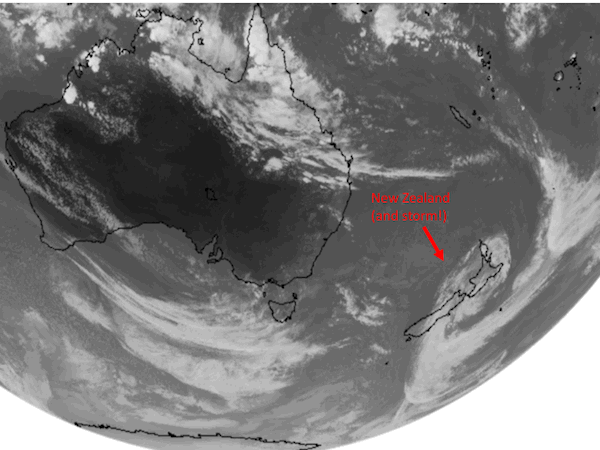 Storm in New Zealand upon arrival I’ve been working on adjusting to the time zone…which is lots easier coming here than it will be go to back to the USA. I’m writing this at about 5:30 pm on Saturday afternoon – which is 10:30 pm on Friday night back in Wisconsin. When I am in Antarctica, I will be on this same time zone. In the flight down – we cross the dateline, and gain a day. When I return to Wisconsin, the day will change again and very likely arrive in Madison at the same day/time that I left New Zealand!
I’ve not been to New Zealand in over 8 years. Hence, arrival here and my walk around the city today was filled with change. The airport here has grown to a much larger terminal with a fancy welcome. The city here suffered terribly in the 2010/2011 New Zealand earthquakes. Some of my favorite places are just gone. Attached here is few examples of the damage that can still be seen – one is of a building that is being held up by steel supports. Some places, there are just vacant lots. The saddest is the Cathedral – also being held up by steel supports. The steeple tower completely fell in. The good news – decisions have been made to repair it! Other places in the city are just as vibrant and lovely as before including the botanical gardens with the roses in bloom, and the Avon river. (Anyone up for punting on the Avon?)
 Chirstchurch, NZ Airport 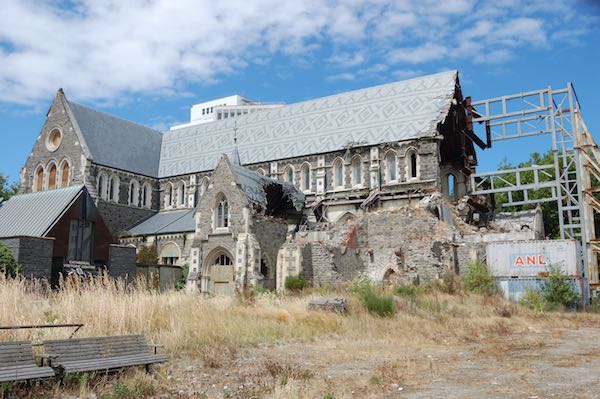 Christchurch Cathedral  Other earthquake damage in Christchurch  Christchurch Botanic Gardens  Avon River More from around the city in my next report!
Best Regards from Christchurch,
Matthew
Hello Everyone!
My name is Matthew Lazzara, and welcome to my e-mailing list on my deployment to Antarctica. As I travel to Antarctica, I wanted my first installment to introduce a few things and get everyone up to speed. Some of you on this list know a whole lot about what I do and what I’ll be doing in Antarctica, but others are new to all of this.
First, a little bit about me. I am full time faculty at Madison College, and part time associate scientist at University of Wisconsin-Madison. At Madison College, I teach courses on weather and climate. At UW-Madison and at Madison College, I am principal investigator of the Antarctic Automatic Weather Station Project and Polar Climate and Weather Station Project. This work is a part of the United States Antarctic Program (USAP), which is overseen by the National Science Foundation.
I’m heading to Antarctica to work on the weather stations or AWS as I’ll call them. This year most all of the work is repairs, digging the stations out of the snow and raising them up to be at a proper level, putting in new power systems to make sure the run correctly, etc. I’ll have more on this as things develop this field season. Stay tuned!
Automatic weather stations (AWS), as seen in the attached map, cover much of the Antarctic continent. While it seems like a lot, it is really very, very few stations. Antarctica is roughly the size of the continental USA and Mexico combined. In those areas, we have thousands of weather stations, while here only hundred and fifty or so stations. My team and I oversee roughly 60 stations – which is the largest surface meteorological observing network in the Antarctic! (My team and I are responsible for all of the AWS marked with a triangle on the map – regardless of the color).
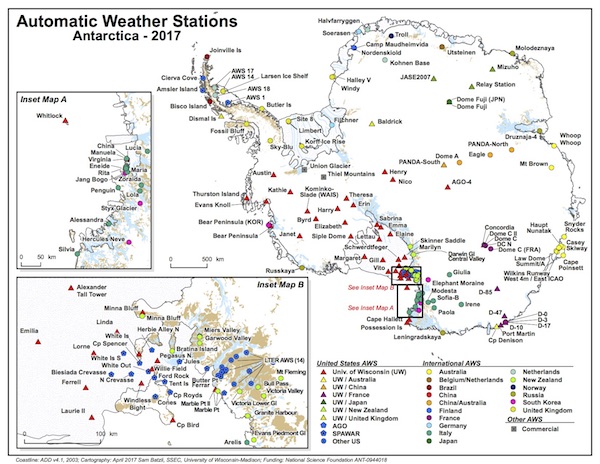 2017 AWS map Looks like the temperatures in Antarctica today aren’t a whole different than some parts of the US – and Wisconsin! (See attached map).
 AWS surface temperatures in Fahrenheit on January 3rd, 2018 Today I fly from the US to New Zealand. I will be reporting more after I arrive in New Zealand!
Thanks again for joining the emailing list!
Best Regards,
Matthew
We got canceled trying to go to WAIS again today, 23 December. We were the backup mission to a Herc flight to South Pole which was activated. Because of the Christmas holiday, McMurdo takes their holiday break for the next two days. As such, we are not on the schedule to try to fly to WAIS again until Tuesday, 26 December.
It’s a bummer that we are getting less time to get a jump-start on our work out at WAIS. This does, however, provide Marian and I a little stability in our schedule for the next couple days. At least for the next two mornings we know we won’t be potentially packing up all our things and moving out.
I’ll leave you all with a couple pictures I took a couple weeks ago when Marian, Joey Snarski (SPAWAR Office of Polar Programs meteorology manager), and I walked to Hut Point on a cloudy and snowy day. Despite the lack of sun, I thought there was still beauty evident in the landscape.
Happy Holidays!
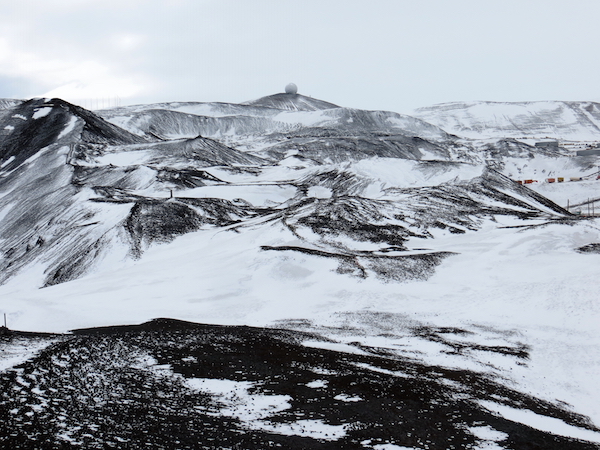
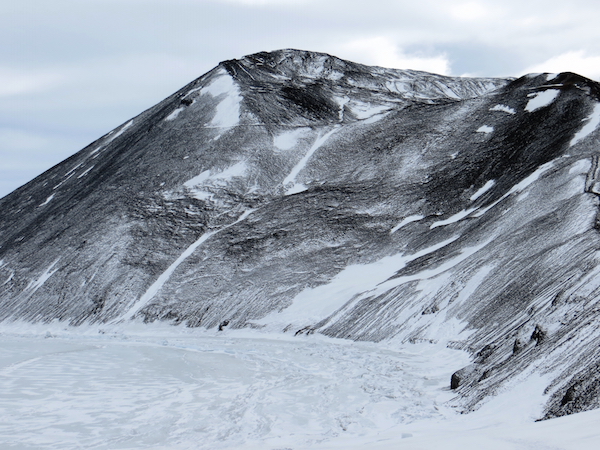
It’s that time of year, when the AWS team tries to go to WAIS. Marian and I have been waiting for this moment. For the past couple weeks, while we have been on the helo and Otter schedule here in McMurdo, we have also been planning and packing for our trip to WAIS.
Last night (21 Dec) Marian and I “bag dragged,” or brought all of our checked bags and hand-carry bags, up to the transport building to get everything weighed for our LC-130 flight to WAIS. This means we will not have access to any bags that we checked until we go to WAIS. It is therefore very important that one packs efficiently and intelligently, so that one’s hand-carry items can provide comfort for as many days as it takes to actually leave for WAIS.
We were hoping that we would be the primary mission today and be able to fly to WAIS. But last night we found out we were the backup mission to an LC-130 flight to the South Pole. This morning, we’ve since found out that all flights are on a 2-hour weather delay. Begin “hurry up and wait.”
One benefit of this slight delay is that I can send this update to you all! Our goal for WAIS is to service 7 AWS by Twin Otter and one AWS in close proximity to WAIS. If all goes as planned, we will have a dedicated Twin Otter, meaning we will be the only group using it, for about the first week we are at camp. That will hopefully allow us to get a good amount of work done. Another science group, POLENET, will be arriving shortly after the new year, and we will be sharing the Otter with them.
WAIS camp will be a little smaller this year than in years past, in terms of population. Our group and POLENET will be the only science groups using WAIS. I think the population will get to about 20 people at its maximum, but in the past I think it’s been at least double that at times.
Marian and I are excited to get to WAIS so we can start flying to more sites! If we do go today, I won’t be able to send any updates until we get back. However, you can be on the lookout for posts coming from Matthew Lazzara (PI of the AWS program), as he and Andy Kurth are due to arrive in McMurdo on 9 Jan! Stay tuned.
Cheers,
Dave
P.S. Here’s a picture of a seal and then a picture of a skua eating a fish, as seen on the Pressure Ridges tour.
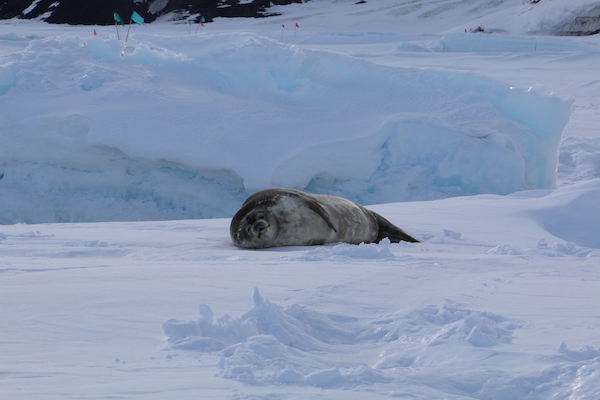
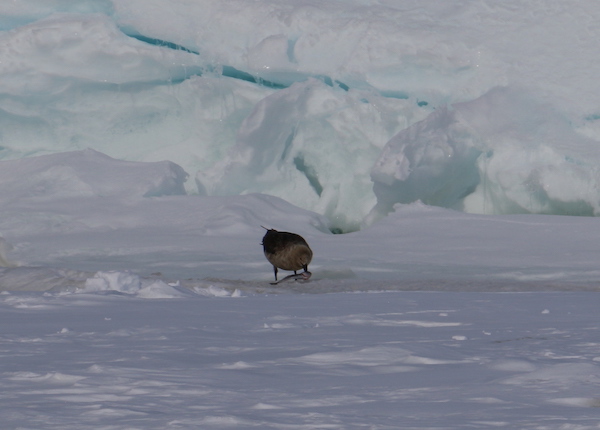
It is long overdue that I give you all an update on our goings on in McMurdo. It’s 19 December, and since the last update I’ve given, the weather has been poor, then pretty good for a few days, and then somewhat poor again. We made it out to Pegasus North AWS on 15 December and Lorne AWS on 16 December, but other than that we have consistently been cancelled due to weather or priority. On our cancelled days, we’ve been able to prepare our cargo that we are bringing to West Antarctic Ice Sheet field camp (WAIS). This week, we have started putting the WAIS cargo into the system so it can be sent out to camp with us. Our goal is to get out to WAIS this Friday, 22 December (which is a few days ahead of schedule (which is unheard of for WAIS!)).
Between our helo visit to Pegasus North and Linda (back when Carol was still in town!) we went a full week of weather and priority cancellations. Carol left just in time: the day after she redeployed back home, a weather system brought in snow, wind, clouds, and low visibility for the next 4 or 5 days. All flights were at a standstill. LC-130 flights, aimed at bringing more pax (passengers) home, were delayed for the duration of the storm. Our Twin Otter and helo flights were also cancelled. These were trying times. As an homage to the repeated weather delays, the movie Groundhog Day was played on TV, on one of two channels that play one movie repeatedly all day. If you’re unfamiliar with the movie, the general premise is that the main character gets stuck reliving Groundhog Day over and over and over again. It was very fitting with the weather delays.
With all this downtime, Marian and I had the opportunity to organize our cargo to be sent to WAIS. We had to get instrumentation organized and ready for Evans Knoll, Thurston Island, and Harry. We also wanted to get another power system built to bring out there, since we will be replacing at least one power system (Austin). It’s always nice to have backups. After the more obvious equipment was packed, we organized all the tools we have available so that both AWS teams (me and Marian, and Matt Lazzara and Andy Kurth who will be coming to McMurdo in January) can still do field work from their respective locations (WAIS for me and Marian, McMurdo for Matt and Andy). Also as a note, this is Matt’s first deployment in many years! It’s been all the talk around town that he will be coming back to McMurdo. Everyone is excited!
On 15 December, weather was finally starting to improve. We were on the Otter and helo schedule, and naturally we were cancelled on Otter. We haven’t been able to be primary on any Otter missions since this Otter is with the New Zealand Antarctic Program, not the US Antarctic Program. That makes it less likely that we will fly, but it’s nice that they put us on the schedule anyways. We were weather delayed on helo, but we figured that delay would inevitably turn into a cancellation, so we took fate into our own hands and said no thank you, we will drive out to Pegasus instead. So we took a Mattraks out to Pegasus Airfield to remove Pegasus North.
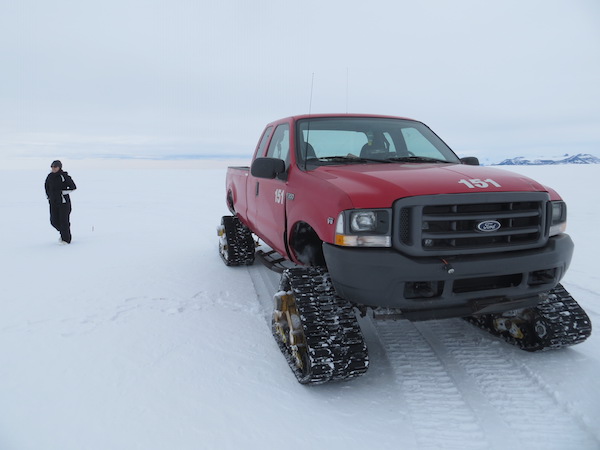 The MatTrak truck We needed to take the Mattraks because we would be driving on an un-groomed road (unsuitable for tired vehicles). Pegasus Airfield is no longer running, so they don’t groom the roads to it. It is a couple miles past the newly opened Phoenix Airfield, so those last two miles were really the only ones we were worried about. It’s slow going with the Mattraks, but we brought some of our music along to help the 1 hour, 15 minute drive go by just like that. When we arrived, we were not surprised to see the AWS did not right itself.
 The leaning tower of Pegasus. We began our work and removed the instrumentation and power system first.
 Just the tower and guy wires remain. Next, we needed to dig/ice pick our way down a couple feet to free the guy wires and tower base, which were frozen into the snow/ice. I was expecting this process to take much longer than it did, and after a little over two hours of ground time we had removed Pegasus North.
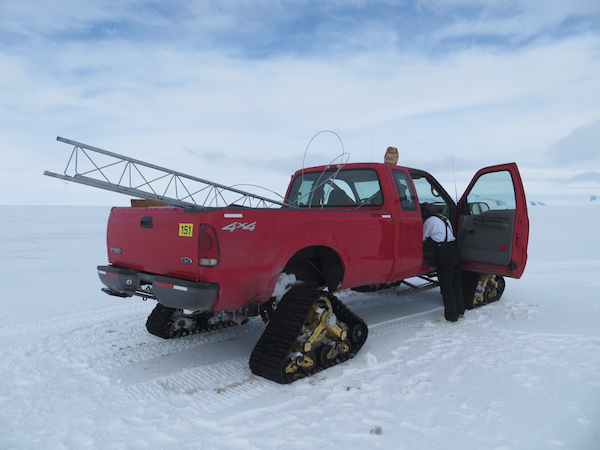 All of the equipment in the back of the truck. 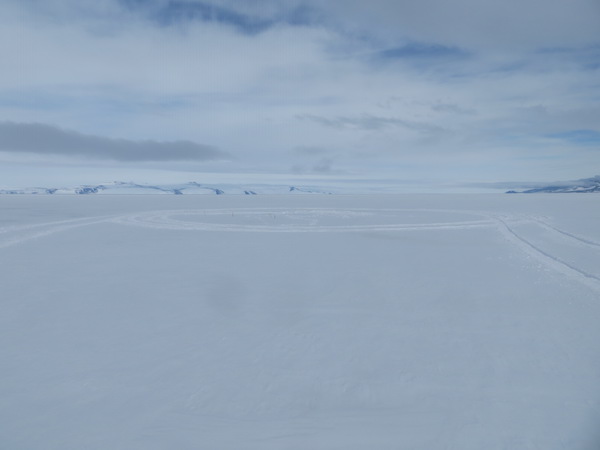 No more Pegasus North 🙁 The next day, we went to Lorne to raise the lower instrumentation and troubleshoot issues we have been having with the Freewave modem at the site. In March 2017, transmissions clicked off unexpectedly at Lorne. Our working hypothesis was that somehow the IP address was reset to its default, which would mean it would not be able to communicate with the repeater site, White Island, to send data back to McMurdo.
While I was troubleshooting the modem issues, Marian and our boondoggler Kristy dug out the power system. From Carol and George’s earlier visit, they had reported that it was very difficult to get the power system to budge from it’s hole even a little bit. They also reported a lot of icing around the power system itself. With those notes, we were worried that it would take a lot of digging and ice picking to free the power system. Overall, I think it went much more smoothly than we were anticipating. Marian and Kristy did a great job of digging the 3 to 4 feet down to get the power out of its hole and up to the surface.
 Lorne AWS upon arrival While they were succeeding, I was not. I attempted to communicate with the modem via the laptop, but the several methods I tried did not work. Eventually, and after much discussion with Lee back in Wisconsin on the Iridium satellite phone, I decided to take the modem back to the lab to troubleshoot it there. As it turns out, despite the modem indicating it gets power, the ports do not turn on, so it can’t send any data. That was unfortunate to discover, as it means we will need to visit Lorne again, but at least we were able to raise the power system and lower instrumentation.
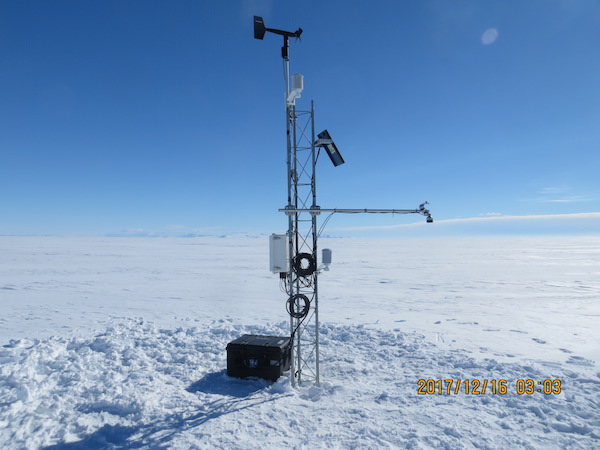 Lorne at the end of our visit. We are on the helo schedule today to fly to Linda to install the Paroscientific pressure sensor recovered from Pegasus North, but the weather appears like it will not cooperate. Regardless, we hope to finish getting the rest of our WAIS cargo into the system and take care of a few loose ends. We are now approaching the time when we will be trying to take an LC-130 to WAIS, which can always be an adventure. I’ll send updates with that when I can!
Cheers,
Dave
As you’ve already heard, Dave Mikolajczyk and Marian Mateling arrived at the beginning of this week. I didn’t get a chance to publish a blog about the week before they arrived, so I’ll finish that up now.
After a few more cancellations, due to priority and weather, I managed to get to Gill AWS. This is a site we wanted to get to last year, but we didn’t have enough time. At Gill, I was tasked with adding a 5-foot tower section, installing a program on the datalogger, and installing a new pressure sensor.
On Wednesday, November 29th, I flew to Gill AWS with 3 helpers from around town. These helpers all were an incredible help and were extremely appreciative of the opportunity to get out of McMurdo. Drew, who’s a janitor, had been in McMurdo since July, so he was extremely excited to get out on the Twin Otter.
Upon arrival to Gill, I was very worried this site would be difficult to find since we had coordinates from 2011 and the site is on a moving ice shelf. Back in Wisconsin, I had found the 3 latest coordinates to make a line and calculate a rate of movement of the AWS. I gave the pilots the 3 latest coordinates, my calculated coordinates, and said good luck! As the plane started to descend I began to hope we would find it quickly. Within about 2 minutes, one of the helpers told me he saw the tower! I was shocked. After we landed, the pilot told me my calculated coordinate was within .10 nautical miles of the true location. I was happy it was easy to find!
As we stepped out of the plane, I noticed that the tower wasn’t as buried as I expected. I decided we would still remove all the instrumentation and add a 5-foot tower section. The lower temperature sensor was buried, so that was the only instrument we had to remove from below the snow surface.
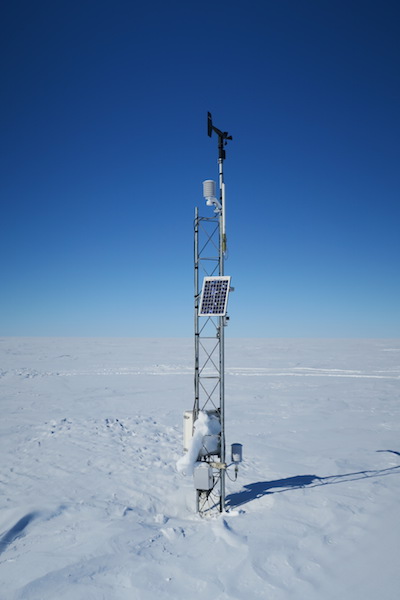 Gill AWS before servicing We got to work right away! Within no time, we were ready to add the tower section. I was extremely nervous to add the tower because I’ve never done it on my own before and these towers usually don’t fit together very well, but not this time my friends! The tower section slide on like a glove, and I was so relieved. I started to add all the upper instrumentation while the helpers from town raised the junction box for the power system. We worked like a great team although we’d never worked together before. Within 3 hours of landing we had all the instruments back on the tower.
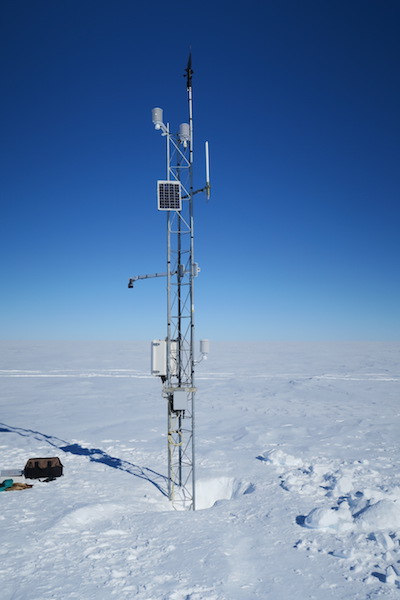 Gill AWS after servicing Then I started to try connecting our laptop to the datalogger to install a new program. This was where I started running into problems. I thought I was using the wrong settings to connect to the datalogger, so I wanted to call one of my co-workers back in Wisconsin. This didn’t work because the phone died. Then I was confused what my next move should be. I didn’t want to incorrectly install a new program because that would mean that we wouldn’t get data until we flew back, so I decided to not install the new program or the associated new pressure sensor. With that, I figured the team would want me to go back once I was more confident with the procedure to finish these last tasks. In any case, I confident I was leaving the site with everything still working like it was before we arrived, so I decided we should go back to McMurdo. The trip was little disappointing because I didn’t get everything done, but I really enjoyed working with my helpers from town!
 From left to right, Drew (Janitor), Ryan (Food Supply), and Kate (MacCenter) Sure enough, I was back on the Twin Otter two days later flying to Gill. This time I had a procedure of 15 exact steps that I needed to follow to install a new program and a new pressure sensor. I also got to take two helpers from town, and they were equally excited and appreciative of the opportunity to get out of town. I got to the site, followed my 15 steps, called my co-worked Lee 3 times along the way to confirm a few things, and I was done in about an hour.
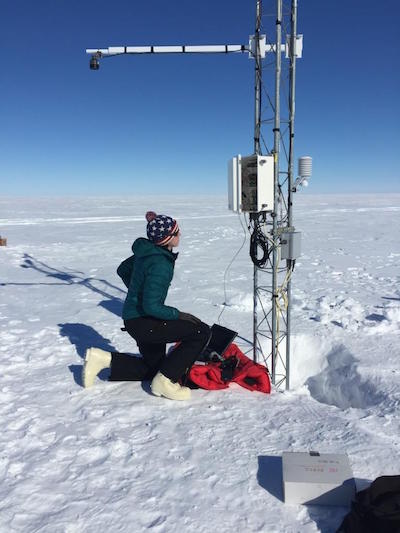 Carol working at Gill AWS. Photo by Rebecca from MacOps It turns out, someone will need to go back to Gill again since there was a minor error with a constant in the new program I was given to install.
With that, I’m writing this last blog on the C-130 on the way back to Christchurch, NZ. My field season in Antarctica is now complete, so now Dave and Marian will be taking over for me!
I wish I could have gotten to more AWS, but thanks for following along with my blog this season!
Cheers,
Carol
AWS field team 2 is on the ice! Marian and I arrived in McMurdo on 4 December, just as scheduled! We are here to take over for Carol, who has gotten the season off to a great start, despite the poor weather that has plagued McMurdo for much of the time.
Marian is a research intern with the Atmospheric and Oceanic Sciences department at UW-Madison. She works in the same building that we do at UW, and she was a student hourly for our group for a year when she was getting her undergraduate degree! We are happy to have her help out on the ice for a part of this field season. She is also blogging about her experiences during this trip and has already made a few posts. You can check it out here: https://marianantarctica.wordpress.com/
For mine and Marian’s portion of this AWS field season, our biggest goal will be to complete field work from West Antarctic Ice Sheet field camp. Our plan is to be there for a few weeks starting at the end of December. We hope to service 8 AWS, with some work including raising and swapping out wind instruments.
Apologies for not updating you all sooner about our arrival, but Marian and I definitely hit the ground running with the mandatory training (field safety, fire safety, Crary Lab walkthrough, truck driving, waste, etc). We have already visited our first four AWS: Willie Field, Phoenix, Pegasus North, and Linda.
We took the truck out yesterday, 6 December, to Willie Field and Phoenix. We used this time to complete the light vehicle training to drive trucks, by which Carol guided us as we drove through town. Once we finished the training, we drove out to the two airfields (Willie Field and Phoenix) to visit our AWS. We wanted to take a brief look at Willie Field AWS, but the main purpose of the trip was to install the relative humidity sensor at Phoenix AWS and introduce Marian to our AWS in their natural habitat. She even put the harness on to climb the station, and she is already practically a pro!
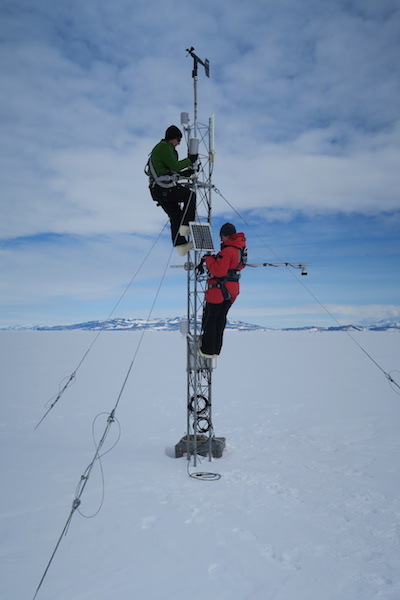 Dave and Marian installing the relative humidity sensor on Phoenix AWS. Today, 7 December, Marian, Carol, and I took a helicopter flight to Pegasus North and Linda AWS. (The original plan was to also go to Lorne AWS, but we were put on weather hold so we didn’t have enough time for that visit today.) We wanted to get some pictures of Pegasus North because we had received word from people working near the AWS that it was very tilted. At Linda, the pressure has been making bad measurements so we wanted to check the wiring of the sensor to the datalogger.
We were on the ground at Pegasus North for all of 5 minutes, enough to get the pictures we needed:
 Yikes! We are deliberating with our team about whether we want to try to fix the tilt of the AWS and keep it installed for one more year, as planned, or remove the AWS this season.
At Linda, we switched some wiring on the datalogger for the pressure sensor. It was still making bad measurements, so we removed the sensor so we can try to diagnose the issue back at the lab. Unfortunately, Linda will not be transmitting pressure for the foreseeable future.
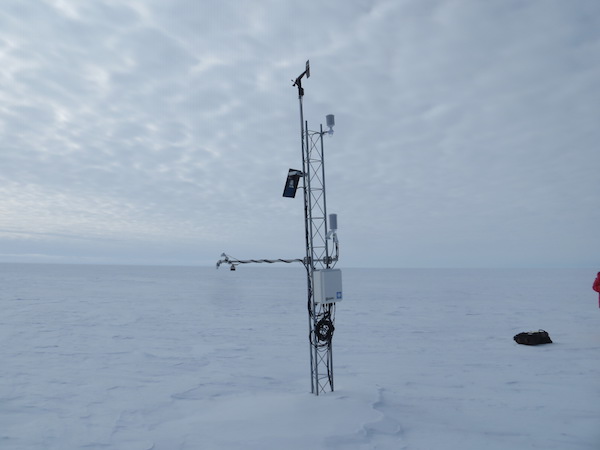 Linda AWS. Consider yourselves up to date now! I’ll be posting again soon with more fun stories.
Cheers,
Dave
On Tuesday, November 21st, George and I got to fly all over Ross Island via helicopter. We needed to wait for the weather to clear up in the morning, but we got to head out at about noon. We wanted to try and hit all four AWS; Cape Bird, Marble Point, Minna Bluff, and White Island. As we were leaving, the pilot thought we should first go to Marble Point so we could get a better view of the clouds at Cape Bird. Then off we went to Marble Point! Here is a map for reference of the four locations.
 Ross Island AWS We have two AWS at Marble Point. The original Marble Point was installed in 1980, and the newer Marble Point II was installed in 2011. It’s incredible how consistent these AWS run because we’ve had almost no issues with their instrumentation or power systems over the years. This year was also the case since everything was in great shape!
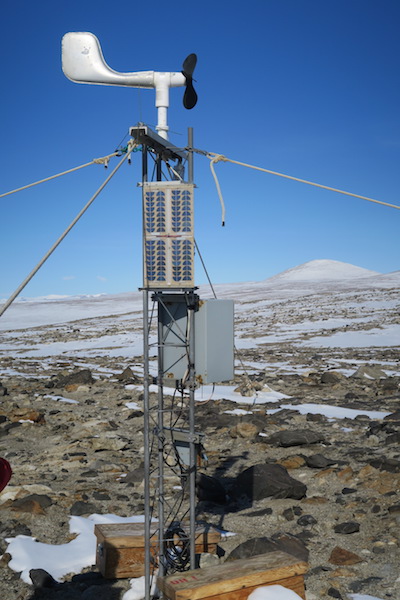 Marble Point AWS  Marble Point II AWS Then our pilot decided that the clouds had lifted enough at Cape Bird, so we flew there next! Along the way we saw a few penguins on the sea ice, and we flew over the 3-mile-long iceberg. We landed at Cape Bird, and there weren’t any New Zealander’s there studying penguins, so no one yelled at us for flying too close to penguins this time. As I’ve talked about many times before, Cape Bird is an epic location full of views of 1,000’s of adelie penguins and small icebergs. In any case, we were still there to inspect the AWS at the top of the hill, so George and I hiked up the hill. The AWS looked great except it had a little bit of sea spray, but that’s to be expected at this location. The new aerovane that Lee installed last year looks to be working great!
 Adelie penguins at Cape Bird 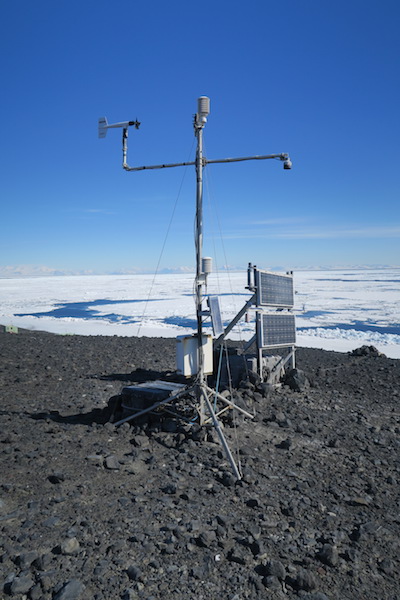 Cape Bird AWS Next, we took a pit stop at McMurdo to refuel, and within 15 minutes we were back in the helicopter on the way to Minna Bluff. Upon arrival, we immediately noticed that the large amount of riming on the AWS.
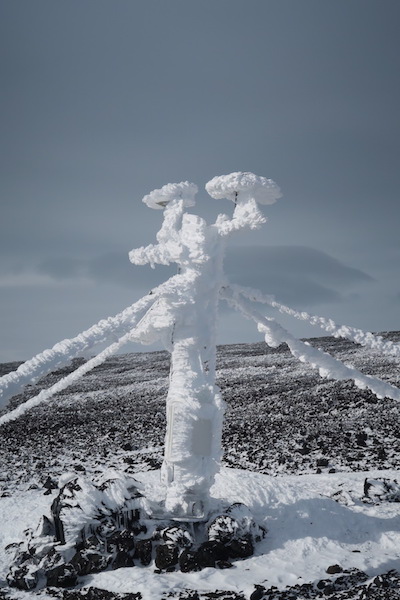 Rimming at Minna Bluff AWS Luckily, the pilot had a little shovel that I could use to knock off all the snow. Then I found that the temperature sensor had completely lost its white plastic shield. I decided to tape down the sensor to make sure it didn’t get blown away.
 Temperature sensor at Minna Bluff AWS Finally, we also noticed that the tower is leaning at about 10°. We’ll need to go back to install a new temperature sensor and try to realign the tower properly.
On Wednesday, November 23rd, George and I got a pickup truck for the afternoon to drive to Phoenix Field to install our instrumentation for a new AWS. We had already installed the tower last week, so I figured it would only take about 2 or 3 hours. For the most part, the installation went very well. I had one issue with the humidity sensor because I noticed that the plastic shield for the sensor was missing one of its long bolts. Dave Mikolajczyk will be bring a bolt from Wisconsin for us to use to fix the shield, and then we’ll be able to install the humidity sensor. Once everything was plugged in and power was connected, I tried to insert a data card. I think something might not have been correct with the card, so now the AWS isn’t transmitting now. Hopefully I’ll be able to go back to Phoenix to test a few other data cards to get it transmitting, but we’re close to getting it working!
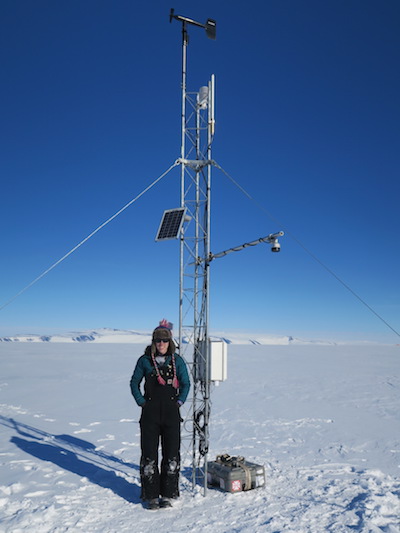 Carol at the newly installed Phoenix AWS As I said in the last blog, make sure to check out George’s blog!
Hope you all enjoyed a wonderful Thanksgiving back in the states!
Cheers,
Carol
Well, the hurry up and wait game has been real strong this season for the AWS project. Since writing the last blog post, we’ve driven to the airfields to install the towers, but we haven’t been able to get out to any other AWS. The weather that we’ve been experiencing in McMurdo is the worst I’ve ever seen. According to the weather service, there were 9.5 inches of snow that fell over a 3-day period! That might not seem like a lot but remember that Antarctica is a desert. It generally doesn’t snow very much here, and I believe that 9 inches might be an average monthly total snowfall for McMurdo. We’re getting used to weather cancellations at this point, but we did manage to experience the bad weather for fun!
As a note, I encourage you all to check out the blog posts that George Hademenos, our PolarTREC teacher, has written over the last month now! He’s done an incredible job of writing about what’s going on around McMurdo since we haven’t been able to get to our AWS. You can find his journals below.
George’s Blog
Back to what’s been happening….. or not happening. Early last week we finished setting up the towers at the airfield with O-456 and help from the riggers. We finished installing all the towers on Tuesday, but I needed to go back with the riggers on Wednesday morning to fix one of towers that we couldn’t connect. We worked quickly on Wednesday morning because we could see the storm approaching from the south.
 Finishing installing the new tower next to Willie Field AWS with Scott, Mikey, Johnny, George, and Mark in order from left to right 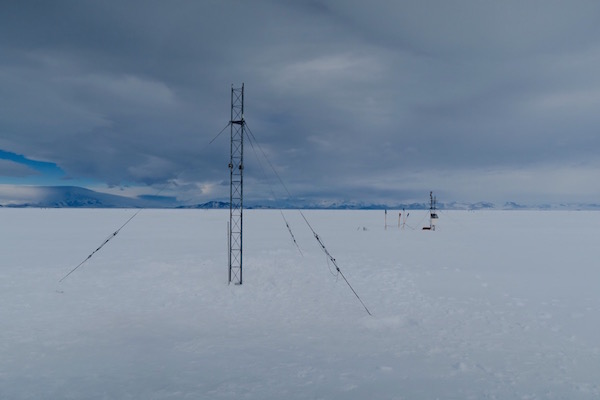 The new tower at Phoenix with the storm approaching in the background Then the weather turned pretty quickly, and it got so bad at the end of last week that we were in condition 2 weather at McMurdo for the whole day on Thursday and most of Friday. Condition 2 weather is defined as winds 48 to 55 knots for one minute, or visibility less than ¼ miles, or wind chill -75° F to -100° F sustained for one minute. Condition 2 is mostly triggered in the summer when the visibility is less than ¼ mile, and that was the case was for the storm last week. I had never experienced condition 2 weather in Antarctica, so I was excited to experience the bad weather! Here are a variety of photos during a walk to we took to Hut Point.
 McMurdo Condition 2 weather 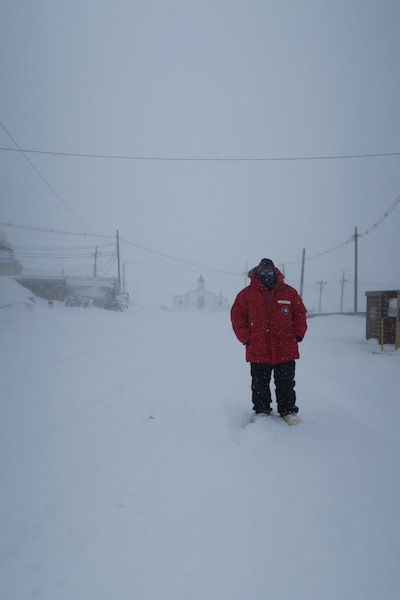 George in McMurdo during Condition 2 weather 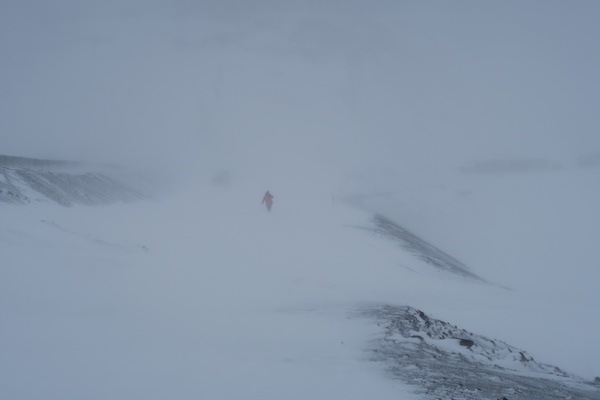 Mark catching up with us on our walk 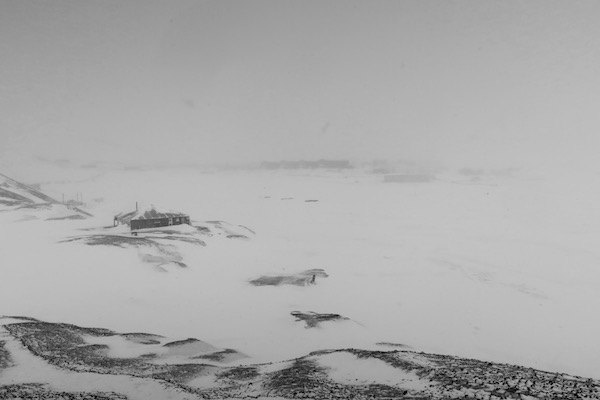 View from the top of Hut Point of Discovery Hut and town 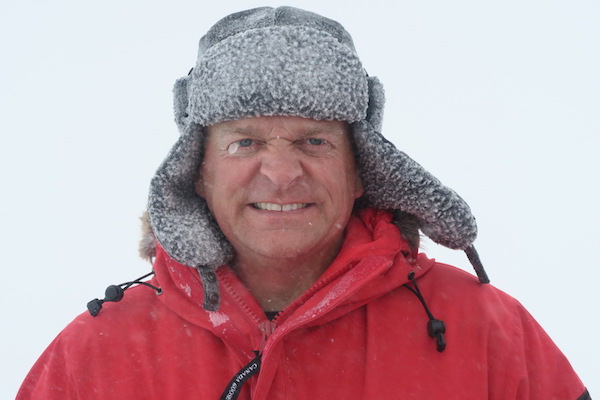 Classic eyelash icicle And with that, that’s all I have as an update. As I said before, I would highly suggest checking out George’s blog to learn more about what goes on in McMurdo!
George’s Blog
Cheers,
Carol
Sorry for the delay in posting blog posts. We’ve been running around McMurdo getting all kinds of things done, but nothing has been very blog worthy. George Hadmenos arrived on November 1st without any deals, so I’ve been doing some outreach activities and training with George for the past week.
Since writing the last blog post, there have been a few things that have been going on. First, the team back in Wisconsin gave me lots of great advice about fixing some major issues with a computer that manages our Ultra High Frequency (UHF) network of AWS. This involved four drives up to T-site which is about a 15 minute drive from our office up a decently step road. I take the classic Ford F-350 big tire trucks to drive up to T-site. On my final trip, I managed to get the truck stuck in some fresh snow. Unfortunately, this truck didn’t have shovel in the bed of the truck, so I couldn’t dig a path to get unstuck. Thus, I was forced to ask for help over the radio. I was initially embarrassed and annoyed that it happening, but looking back at it now it was funny. A very kind human used his truck to pull my truck out of the snow!
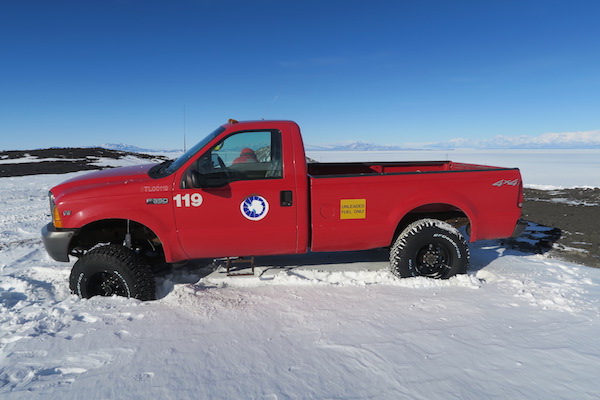 The stuck truck 🙁 Second, we took a trip to Willie Airfield and Phoenix Runway to mark with flags where we’ll be installing two new AWS. One new AWS will be installed near our other AWS at Willie Field and that will be for the MRI in collaboration with Madison College. The second AWS will be installed at Phoenix Runway. Willie Field is about 25 minutes from McMurdo, and Phoenix is probably another 20 minutes from Willie Field. After marking the locations of the tower with flags, we then drove back on a different day to drop off the tower sections and dig the holes for the tower sections. This time we took a mack-tracks which is a truck that’s specially designed to drive over ungroomed snow. These trips were done in collaboration with Mark Seefledt and Scott Landolt of project O-456 because they are installing precipitation instrumentation at the same locations.
 Flag to mark where we’re going to install a new AWS 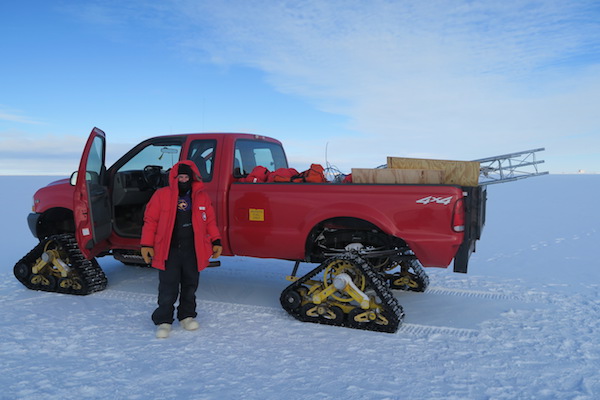 George and the mack-tracks Finally, we managed to take a helicopter to Lorne AWS. This flight is only about 30 minutes grid west or true east of McMurdo. Lorne hasn’t been transmitting data since the end of March. We thought this might be due to a difference between the clock in the modem at Lorne versus the actual time. The first thing we checked was the modem clock and it was correct, so we knew the problem must be something else. I figured this wasn’t something we would be able to fix in the field, but I still called my co-worker, Dave Mikolajczyk, to see if there was anything else I should check. He suggested a power cycle, so we unplugged the power system and worked to raise the power system. This was when things got tricky. George and I freed the box most of the way around all the sides, but it was still too stuck in ice for the two of us to move it. The box weighs 250 lbs. since it has three 70 lbs. batteries. Knowing that, I removed one battery to make the box lighter, but we still couldn’t lift it. At that point, we only had about 20 minutes left of our 2 hours of ground time before we had to leave since the helicopter pilot needed to stick to his schedule. I decided to put the battery back in the case and plug everything back in. In the end, I didn’t plug everything back together completely, and I don’t think the AWS is getting power. George and I will be going back to Lorne with two more strong helpers from McMurdo, more ice picking equipment, and more time. With all those factors, I’m confident we’ll be able to get the power system raised. Also, the team back in Wisconsin figured out the reason Lorne wasn’t transmitting was an issue with the timing of the repeater it was trying to transmit through. Thus, once the power is properly connected at Lorne it should start transmitting again!
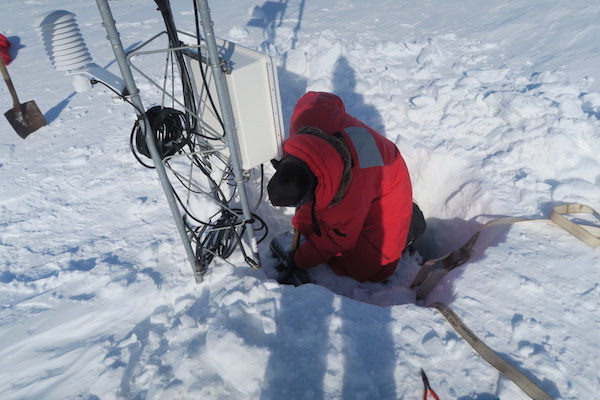 George digging at Lorne AWS system[/caption]
 Carol after removing one of the batteries and still not being able to lift the power system We haven’t been able to get on any Twin Otters flights due to priority and bad weather, but I’m hoping that will happen next week. I’ll keep you updated!
Cheers,
Carol
|
|


















































